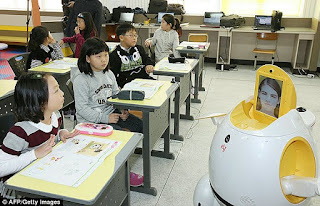The prospect of robots replacing human workers has prompted discussions about mitigating potential economic impacts. Bill Gates' suggestion of taxing robots that displace human labor is one such proposal aimed at addressing the societal implications of widespread automation.
However, the application of robots in education raises unique concerns. While some envision a future where robots assist or even replace teachers, this raises fundamental questions about the nature of teaching and learning. The 1999 film "Class of 1999," which depicts robot teachers imposing extreme order with potentially harmful consequences, serves as a cautionary tale about the potential pitfalls of unchecked technological intervention in education.
While robots are being developed for roles across various sectors, including chefs, surgeons, factory workers, and even teachers (like the humanoid Pepper), the idea of fully replacing human teachers is particularly contentious. While robots can deliver information, the core of effective teaching goes beyond data transmission.
Ten key reasons highlight why robots cannot effectively replace human teachers:
- Deep Learning: True deep learning involves personal reflection and inspiration, fostering a desire for knowledge that is difficult to replicate through algorithms.
- Inspired Teaching: Human teachers inspire learners through their own passion and enthusiasm, a quality that cannot be programmed.
- Core Skills Development: Essential skills like collaboration, critical thinking, creativity, and imagination require human interaction and guidance.
- Emotional Intelligence: Understanding and responding to the complex emotional landscape of a classroom requires nuanced human judgment and empathy.
- Human Interaction: Learning is deeply social. The teacher-student relationship, built on trust and rapport, is crucial for effective learning.
- Managing Complex Student Dynamics: Experienced teachers navigate complex classroom dynamics, including students with manipulative behaviors, a challenge that would likely overwhelm current robotic systems.
- Classroom Management: Effective classroom management requires adaptability, creativity, and psychological insight, qualities difficult to encode in AI.
- Psychomotor Skills Instruction: Teaching psychomotor skills often relies on observing and responding to individual student progress in real-time, requiring a level of intuitive adaptation beyond current robotic capabilities.
- Guidance and Counseling: Providing effective guidance and counseling relies on human experience, empathy, and understanding of individual circumstances.
- The Human Element (Soul): Teaching involves connecting with students on a deeper level, fostering not just intellectual growth but also personal development. This human connection is difficult to replicate artificially.
While robots can be valuable tools in education, they should be viewed as enhancements to human teaching, not replacements. They can assist with tasks like delivering information, providing personalized practice, and collecting data, freeing up teachers to focus on more complex and nuanced aspects of teaching.
The potential displacement of human labor by automation necessitates a proactive approach to workforce development. As new technologies emerge, it is crucial to invest in education and training programs that equip individuals with the skills needed for the jobs of the future, including roles in robotics, programming, and other technology-related fields.
In conclusion, while the increasing role of technology in education is inevitable and potentially beneficial, the unique qualities of human teachers – their empathy, creativity, and ability to inspire – remain essential for effective learning. The focus should be on leveraging technology to enhance human teaching, not replace it entirely.

Comments
Post a Comment